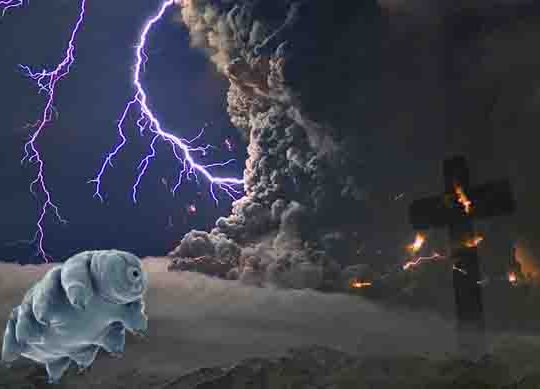Eternal?

Some life forms are indestructible, they say.
David Sloan, Rafael Batista, and Abraham Loeb, from the University of Oxford and Harvard, said so in “The Resilience of Life to Astrophysical Events,” a scientific report recently published in the respected journal Nature.
They concluded:
Events which could lead to life being completely eradicated are rare.”
Because those tardigrades will have survived even those disasters!
Also known as “water bears,” these tiny things (about half a millimeter long) are eight-legged, segmented beings, and are found on mountaintops, in the deep seas, in volcanoes, in the Antarctic, and even in tropical rain forests. And they are virtually indestructible! Temperatures may sink down to –458°F or soar as high as 300°F, but these beasts will survive. Pressures six times greater than what is found in the deepest oceanic trenches, ionizing radiation at levels hundreds of times the lethal dose for humans, outer space vacuums—nothing affects the tardigrade. Apparently, they can go without nutrition for more than thirty years, dry out to a point where they are less than 3% water, and still return to abundant life when rehydrated. That’s your miraculous Milnesium tardigradum!
We consider the relative likelihood of complete global sterilization events from three astrophysical sources – supernovae, gamma-ray bursts, large asteroid impacts, and passing-by stars. To assess such probabilities we consider what cataclysmic event could lead to the annihilation of not just human life, but also extremophiles, through the boiling of all water in Earth’s oceans. Surprisingly we find that although human life is somewhat fragile to nearby events, the resilience of Ecdysozoa such as Milnesium tardigradum renders global sterilization an unlikely event.”
Confessed one of the co-authors, Rafael Batista:
Tardigrades are as close to indestructible as it gets on Earth, but it is possible that there are other resilient species examples elsewhere in the universe. In this context there is a real case for looking for life on Mars and in other areas of the solar system in general. If Tardigrades are earth’s most resilient species, who knows what else is out there.”
All this, of course, is not much relief to us fragile humans. Not that we didn’t know this already.
But the day of the Lord will come like a thief,
in which the heavens will pass away with a roar and the elements will be destroyed with intense heat,
and the earth and its works will be burned up.
2 Peter 3:10
(I doubt if tardigrades will stand a chance.)
This event likely will occur at the end of the Millennium, the 1000-year period of the reign of Christ, at the end of which, Satan will be defeated and eternity will be ushered in.
When the thousand years are completed, Satan will be released from his prison,
… to gather [the nations] together for the war ….
And they came up on the broad plain of the earth
and surrounded the camp of the saints and the beloved city,
and fire came down from heaven and devoured them.
And the devil who deceived them was thrown into the lake of fire and brimstone ….
Revelation 20:7–10
And then God will author a new creation!
Then I saw a new heaven and a new earth;
for the first heaven and the first earth passed away.
Revelation 21:1
(Not sure about tardigrades, though.)
How does that impact our lives now?
Since all these things are to be destroyed in this way,
what sort of people ought you to be in holy conduct and godliness,
looking for and hastening the coming of the day of God.
2 Peter 3:11–12











 Abe Kuruvilla is the Carl E. Bates Professor of Christian Preaching at The Southern Baptist Theological Seminary (Louisville, KY), and a dermatologist in private practice. His passion is to explore, explain, and exemplify preaching.
Abe Kuruvilla is the Carl E. Bates Professor of Christian Preaching at The Southern Baptist Theological Seminary (Louisville, KY), and a dermatologist in private practice. His passion is to explore, explain, and exemplify preaching.